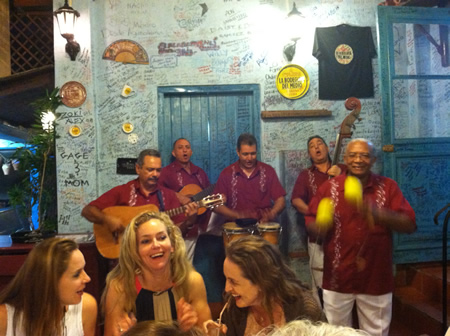By Ed Kaufman, Special to the Independent

“Fine art!’ “Salt Fine Art!” The cry resounded throughout the streets of Havana, Cuba, the week of March 10 as our faithful guide Vivianna struggled to tear an intrepid group of art lovers away from one exciting artist after another to help us complete a rigorous itinerary of art, architecture and dance.
There were 21 tourists and four guides, the majority of whom were Laguna Beach residents. The trip was co-sponsored by the Museum of Latin American Art in Long Beach, which provided two very experienced facilitators, and Laguna Beach gallery Salt Fine Art. Owner Carla Tesak Arzente and gallery director Suzanne Walsh went along.
Art and politics were inseparable wherever we went. Our biggest surprise was the architecture, despite the fading elegance of the city. Everywhere we turned we saw a different style, representing the influence of the country that had exerted the most political power in the era that the building was constructed: Spanish Colonial, Neo-classical, Art Nouveau, Art Deco, Modernism, Revolutionary and Contemporary. But even more striking than the variety of styles was the range of fading grandeur, at times with the striking patina that only aging and lack of repair can bring, and all too often with sad decay. We strolled with a feeling of safety everywhere we went, assured by our guides there was no private ownership of guns or knives in Cuba.
The art was amazing and so relatively well- priced that each of us had to restrain ourselves from purchasing no more than a half-dozen pieces. The work was generally either political or mystical and always quite creative. Many artists had found their way into lovely living places, which were also their studios and galleries. There were almost no fine art galleries, just collectives. Student artists are discouraged from selling their work for fear they would become overconfident early in their careers. Still, our group purchased many student pieces at the National Art Academy, an architectural wonder with the inner courtyard depicting a woman’s reproductive organs.
The cuisine was the most consistent aspect of the tour. Quite often there was a welcome mojito, followed by a local appetizer plate consisting of what looked like tater tots. Next came our choice of fish, chicken or shredded meat and for our first dinner, lobster, served with taro, rice and beans. Desert was flan, ice cream or rice pudding. Despite the similarity of the menus, the food varied from tasteless to excellent. However, each setting was more spectacular than the next, ranging from glass walled dining rooms hanging over crashing waves to formerly elegant palaces with delightfully decadent decaying stone walls blended with modern fixtures.
The tour group was wined and dined graciously in the homes of the artists we had come to meet. In one case we ate on a set of plates that depicted 32 versions of Castro copulating with Cuba, each piece showing an era of the leader’s relationship to the country. When we ate at the converted home restaurants there was always a house band or a group of traveling musicians to serenade our group or entice us into a mad salsa on a small dance floor.
Another surprise was the three amazing private dance performances staged for us. The ballet company directed by Laura Alonzo was as innovative as a Laguna Dance production. We were treated to three performances in threadbare ballet slippers. The final was a unique experience in which the soloist performed a seductive snake dance. Stuart Ashman, MOLAA’s president, donated a greatly appreciated box of ballet slippers to the company. Equally impressive were two other dance groups we saw later in the week who performed a distinctly different form of flamenco and a folk company who performed an Afro-Cuban trance dance that put our group into an altered state.
We drove to our last night’s meal in a caravan of six convertibles from the ‘50s with musical horns blasting through the streets of Havana. For the moment we felt we were one with the fun loving people of Cuba.
Ed Kaufman is a Laguna Beach psychiatrist and author of the travel memoir, “From Monks to Mountain Gorillas.”




